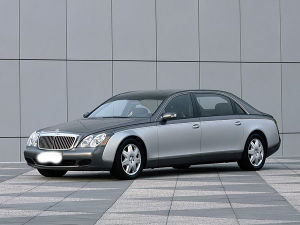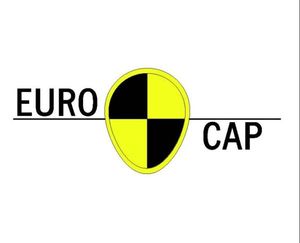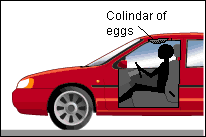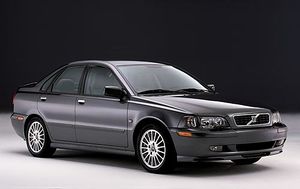Euro EggCAP
“Is there an EggCAP rating in new cars?”
– James May on Euro EggCAP.
“Euro EggCAP.”
– Jeremy Clarkson followed.
Euro EggCAP is a car safety organisation that focuses on the car's ability to absorb bumps without violently shaking the cabin. Established in 1995, cars were tested on a rocky road to test their ability to absorb bumps in really bumpy conditions and to really test this, the cars contained eggs to carry along through the test. Ratings were given for any eggs cracked and broken or unscathed.
Origins[edit | edit source]
Its origins didn't much start the whole organisation but the car trial. Since 1931, cars made by French firm Citroen and many others did test runs on bumpy country roads in France to test how well the cars absorbed bumps. The cars tested had 60 eggs on 2 cartons laid on the back seat, and number of eggs broken would be recorded after the test - as an example, if 15 eggs were cracked, the car rated EggCAP 45. Citroen cars were ranked the best while other French cars such as Peugeot and Renault were not as good because in their test runs, eggs bounced off their cartons.
Then, in 1940, other carmakers all over Europe came to the test track to test out their cars' suspension systems. Mercedes Benz had been one of the carmakers to use the test track for their engineering purposes and it helps the car makers to make the best performing suspension systems.
But then, there are problems. Some carmakers started to become jealous of the French cars that dominated the rankings and the test track started to fill up with too many cars queuing up so firms had to look elsewhere. Many carmakers had developed their own bumpy test tracks for their prototypes and by 1973, the testing at the French bumpy roads had ended and many car makers agreed that the testing is getting unecessary.
How the test goes[edit | edit source]
To set up
There are four things required to do a Euro EggCAP test. First, they need a car to test. Second, the car will have a small colander of 4 eggs attached in the roof of the car above the driver's head. And it'll be also held by duct tape. Thirdly, the test requires a rocky track. Usually located at the test site, the track is constructed with concrete with rocks and bits of broken cement and bricks and it measures along at 328 ft (100m). And lastly, the driver is required.
Testing procedures
The testing procedures got more interesting. Firstly, the test runs for only one car at a time. In test time, cars being tested are to be driven at speeds of 50 km/h (30 MPH) on the rough track and after that, the rating will be carried out and most importantly, cars next to be tested have to wait until the test already in progress is fully complete
The ratings[edit | edit source]
The way the ratings go in Euro EggCAP are simple. If any eggs are cracked or broken, one point is lost per 1 egg. Here are the ratings.
4 points: Best No eggs cracked or broken
3 points: Good 1 egg cracked of broken
2 points: Average 2 eggs cracked or broken
1 point: Marginal 3 eggs cracked or broken
0 points: Worst All eggs cracked or broken.
The Best and the Worst Performers[edit | edit source]

The Best
The best Euro EggCAP result goes to the Maybach 62 tested in 2002. It's hefty 6,184 pounds has managed to absorb the bumps thanks to its advanced suspension system which helped keep the car stable through the track and therefore, no eggs were cracked. Suprisingly, although its wheels appear small compared to the big body, it did little to interfere its smoothed out ride but best of all, the test driver got away with no yolk in his hair whatsoever.
Rating:4
The Worst
The worst Euro EggCAP result goes to the Volvo S40 tested in 1995. Volvo's reputation of being safe didn't much cover rough ride absorption as proved by the test. Its body rocked through the track and compared to the Maybach, the Volvo's lighter, it has a marginally higher ride and it's cheaper and none were any help. Worse still, its hard suspension helped made matters worse and the result is that all of the eggs are broken. After the test, the test driver had go in the shower to wash his hair but the car retained its shape well.
Rating:0
Other EggCAP organisations worldwide[edit | edit source]
Around the world are various versions of Euro EggCAP listed below.
- IIES (Insurance Institute for Egg Safety)
The Insurance Institute for Egg Safety is an EggCAP organisation running in America. All cars sold in America are tested there and the differences with Euro EggCAP are that the test track is longer (up to 3445 ft long) and the speed the cars to be tested is lower to 40 km/h (24.84 MPH) to be more fair towards Euro EggCAP.
- JapEggCAP
JapEggCAP is a Japanese version of Euro EggCAP but unlike IIES and Euro EggCAP, they test separate classes of cars instead of cars from all classes. In JapEggCAP, people movers, off roaders and commercial vehicles are tested.
- EggCAP Asia Pacific
EggCAP Asia Pacific tests cars around the Asia Pacific region and it's much more similar to Euro EggCAP. However, the tests are to be done under controlled temperature conditions.
- EggCAP Canada
Canada has its own EggCAP facility which is formally known as EggCAP Canada. It's much similar with IIES with the same travelling speed, the same cars tested by IIES and available in the canadian market but the test track is rougher. Apart from all this, the tests will benefit for test drivers because of the cooler climate.
Facilities[edit | edit source]
Here are some Euro EggCAP facilites.
- Oxfordshire, England, United Kingdom
- Lladwelsky, Wales, United Kingdom
- Metz, France
- Bialystok, Poland
- Espoo, Finland



